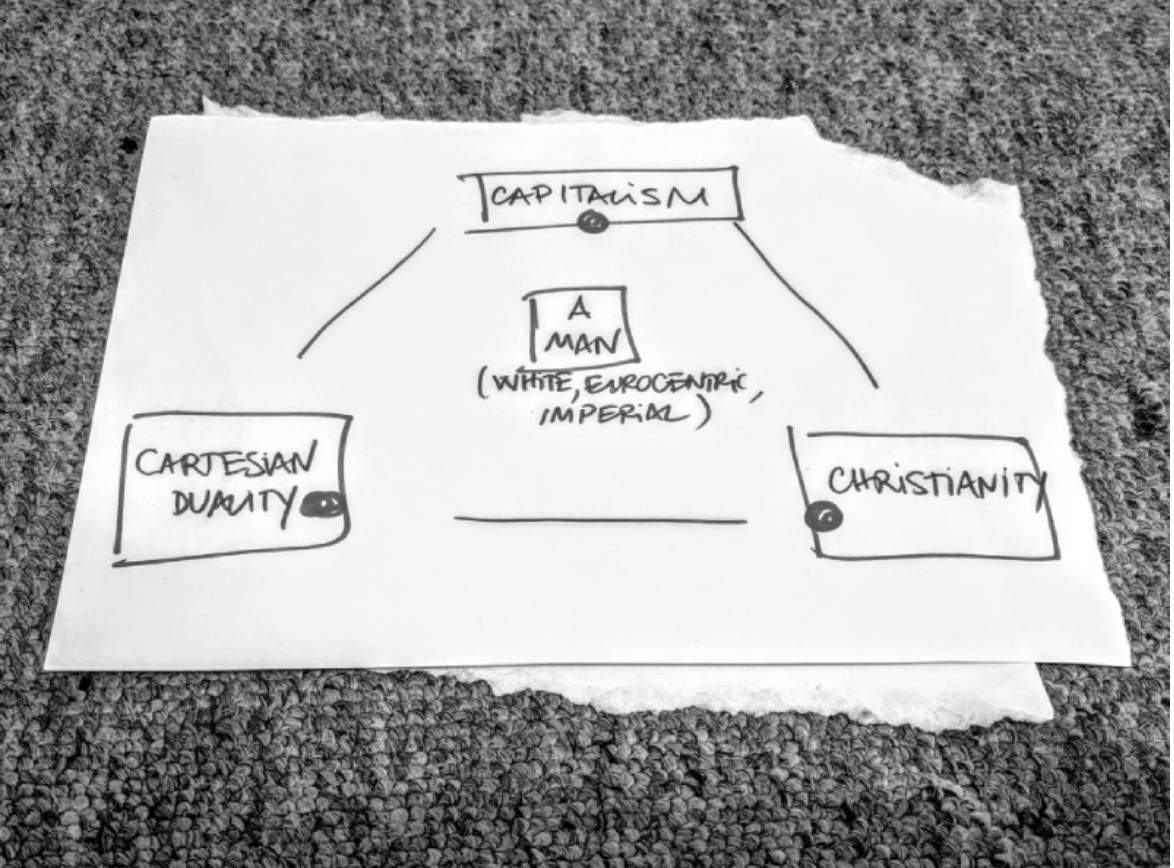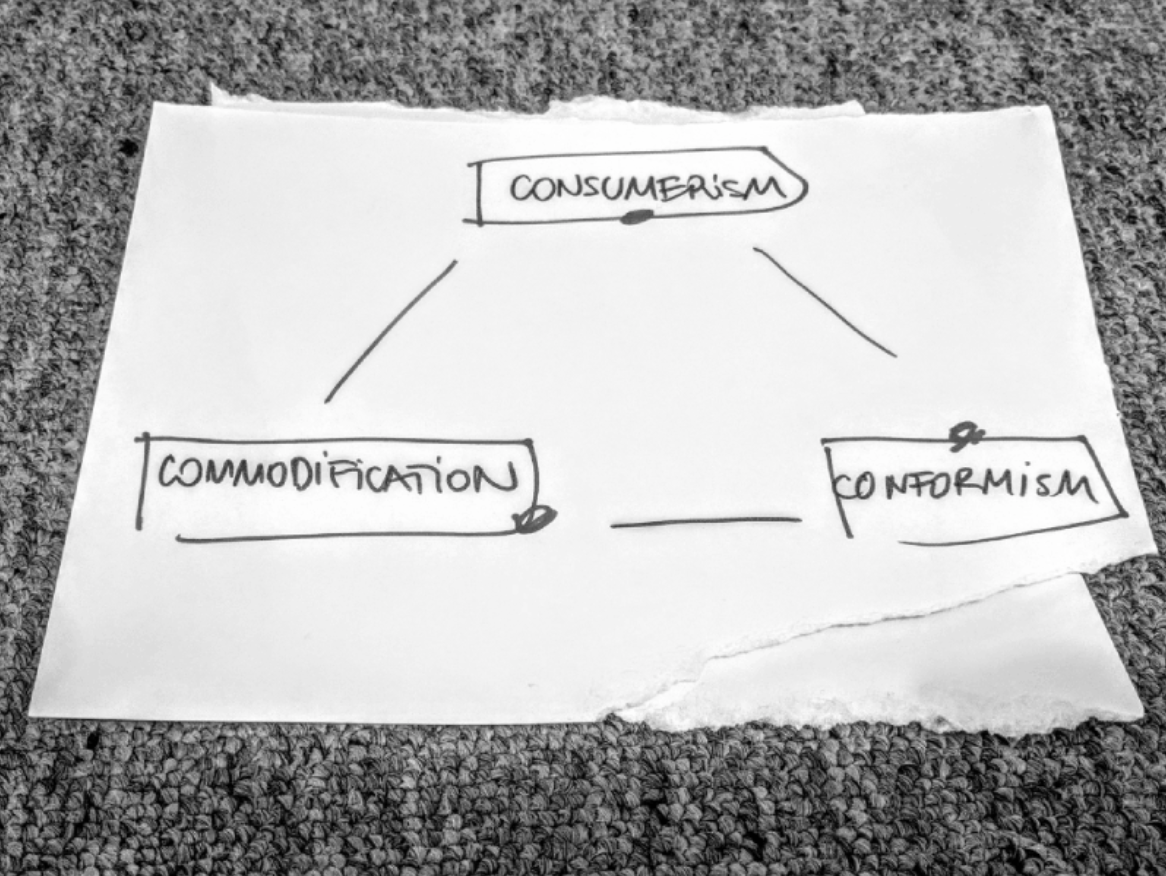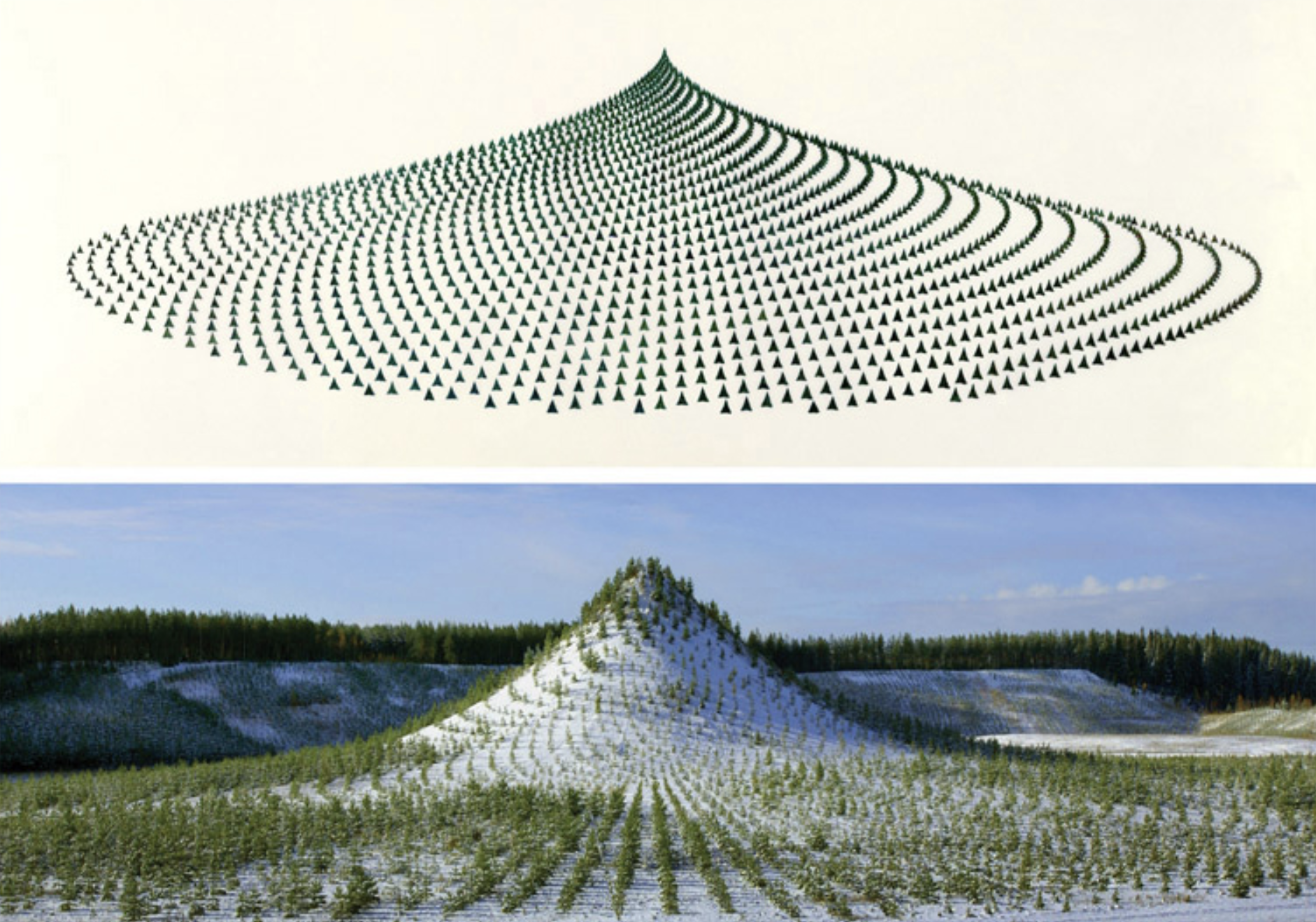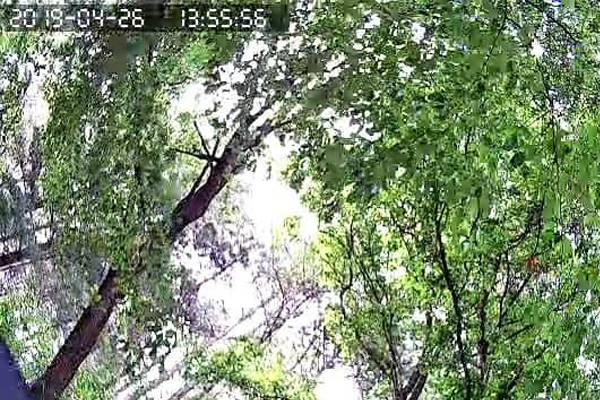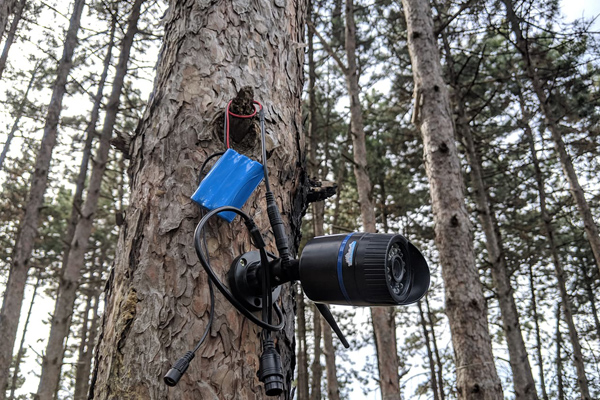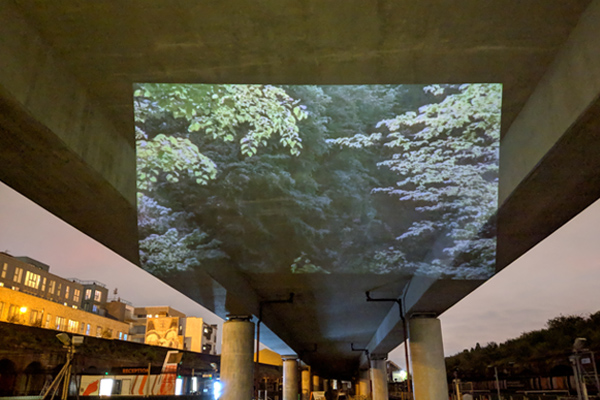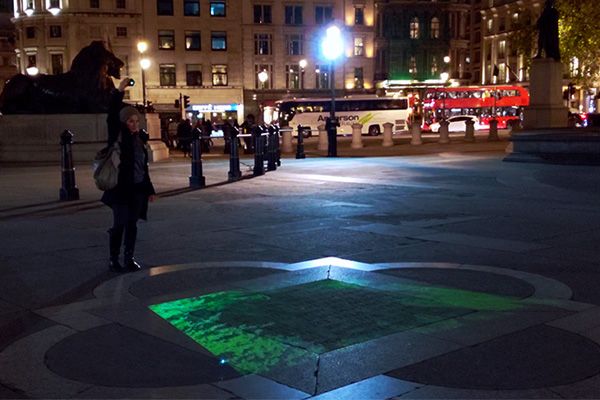Woods.Live.
Why do we need a latte rebellion?
Woods.Live are woods projected onto urban spaces, almost surprising the passers-by with what should have been quite familiar to them - their (vanishing) habitat.
produced by: Katarina Popovic / ketworks.com
It's not that any relevant art needs to be political. It needs to be ecological and political.
We need ecological punk.
One of the first records I recall listening to repeatedly was (luckily for me) London Calling by the Clash. To put on the side the fact that my cultural taste and rebellious zing was set on the right track very early on, the themes are ringing too close to home now. Strummer’s lyrics were no Gaga. I also remember turning the record cover to read the words over and over again to try to understand what was he singing about:
The verses were from 1979 when a small nuclear “error” happened in the USA while Clash was on tour and Strummer was living by Themes (1), but at the moment I was discovering them, in 1986, the Chernobyl “error” happened contaminating Western Europe and Russia with radiation. And ever since, the reality I inhabit was overshadowed by extensive and violent intervention into the natural order of things. It is 2019 now and I am realizing that it is by no means better and that all of the work I will make in my life will be oriented towards saving what was left of this planet after the mindless Anthropocene pest invasion. After us.
This is not a calm, objective observation, we are in the middle of the extinction drama. This will be a mix of research and a manifesto. I will be writing about woods as if my life depends on them. Because it does.
There is no revolution like the survival revolution. We are fighting our own selves. It is not political, religious, nor ethnic per se. And it is all of this, at once. The Cold War scare for the Millennials' generation is the actual extinction. The amount of packaging we buy. The unrecorded number of cigarette buds and hygienic pads. The diapers. The straws. Our amazing unawareness and laziness. The fact we are having a latte while reading this. We are re-creating this crisis again and again with almost everything we do.
It is written in our habits. And this is what’s making it so frightening.
How did we get here?
Nature is a “given” constant, something “free” and “there” and ready to be used by us, because, lo and behold, we are the Planet’s most intelligent species and we know what is best for our own progress and development. Right? Wrong. A question of how did we find ourselves in the situation that this May 2019, the UN report on biodiversity has reported that almost 1 million species of plants and animals are facing extinction, (many within decades) will put all our intelligence into a proper perspective. And not a bright one, either.
There is an interesting socio-cultural construct that has brought about this situation. It consists of three pillars - Cartesianism, Christianity, and Capitalism. And in the middle of it is not an enlightened man (sorry, not sorry DaVinci and Descartes) but “a white, eurocentric, imperial man” (2) who is hungry for growth and profit. Interestingly so, there are more “C’s” to be added to this triangle - Consumerism, Commodification, and Conformism. It almost looks like a 3C triangle within a triangle - the outer triangle is the religious, cultural and social construct and the inner triangle represents the results that are coming out as our main behavior traits. It is almost like a viral loop in a program that feeds on itself until everything is gone and the entire system fails. Literally.
The Cartesian duality that has split our perception into a viable (rational) and unreliable one (senses) somehow goes hand in hand with the Christian duality of our life on Earth being sinful and less important than the promised land waiting for us in the afterlife. Reduced to a rational mind and looking up to the sky, we actually failed to view the entire habitat as our own constructor. In both doctrines, there was never a clear instruction on how to treat nature within our “human situation”. The “answer” was unfortunately injected from the scientific research - On the Origin of Species by Charles Darwin. The evolutionary survival of the fittest (by which the natural selection is made according to Darwin) was directly translated to the socio-economic system in which capital is the selector of the “greater” and “lesser” humans.
“Owning to our distorted ideas of both external and internal nature, our experience of nature has been immeasurably impoverished, diminished. In our ceaseless attempts to dominate nature, we have turned nature into something to be controlled and manipulated exclusively for our own benefit by reducing nature to our concepts of it on the theoretical level and by equating nature with its exchange value in the capitalist marketplace.”(3)
In fact, Adorno agreed with Marx, and claimed that “capitalism now appears in the guise of second nature because it seems to be governed by natural, immutable laws.” (4) Without even opening the questions of plastic abuse and fossil fuels, let us just add our growing tech development and the sourcing of new materials (lithium for batteries, as an example) creating new world inequality while we enjoy our chrome colored laptops, and the creation of the fast-growing piles of used hardware (because new software drives hardware production, yei!) - toxic, non-recyclable technotrash.
We are cancer
In the brilliant writing - Resisting Reduction: A manifesto. Designing Our Complex Future With the Machines, Joichi Ito points out our cancerous behavior of the progress-driven world, with utter disregard to the (eco)system and at the total expense of it:
“Healthy cells regulate their growth and respond to their surroundings, even eliminating themselves if they wander into an organ where they don’t belong. Cancerous cells, on the other hand, optimize for unconstrained growth and spread with disregard to their function or context.” (5)
Reflecting back to the aforementioned 3Cs triangle, the self-regulating system does not function in a pyramid structure. It operates in a circular structure, where each element depends on the other and regulates it in return. While we enjoy our latte while rushing to our urban works and desires, it is very hard to be aware that coffee plantations are killing the habitat. How to grasp that, you would ask? It is just coffee! Our hipster brew in our “First World” comes with deforestation, erosion, pesticide usage and the killing of the animals “Somewhere Far Away”. The metaphor of cancer is thus a perfect one - it is a slowly growing beast, showing no signs until it metastases all over the host body and kills it. The end of the world is not coming with a nuclear bomb, as we used to fear, it is coming with our Instagram breakfasts. We are unaware, distant and separated in our progress kingdom (as any monster throughout history has been) while we rapidly feed on the last remains of the natural resources. In the review of the recent Venice Art Biennale gold winners’ brilliant Brechtian contemporary opera and performance piece “Sun & Sea (Marina)”, Julia Halperin writes:
“It’s delightful to watch and listen to these performers sing in this sunny space and novel configuration. It’s only after sitting there for a while that you realize this is how the world actually ends. Not with a bang, but with something much more human: resignation, self-absorption, laziness. As the pavilions’ organizers note, “contemporary crises unfold easily, softly—like a pop song on the very last day on Earth.” “(6)
There is no experience outside of the “experience”
Our separation, our enclosed life within our urban cocoons and habits is well supported and reinstated by the commodification of almost everything and the utter dominance of the visual interpretation on numerous screens.
“Understood in its totality, the spectacle is both the result and the project of the dominant mode of production. It is not a mere decoration added to the real world. It is the very heart of this real society’s unreality. In all of its particular manifestations — news, propaganda, advertising, entertainment — the spectacle represents the dominant model of life.” (7)
Along with separating us from the “real” reality, the spectacle, as Guy Debord points out in The Society of the Spectacle, is characterized by the lack of two-way communication – it talks to itself and its by-products are reinforcing its values back in an endless loop. In order to ‘show’, you need to ‘have’. And you will work on having, even to the point of living that serves the sole purpose of you having something desirable. (8) Our gadgets are our spectacle-to-go. We need ways to break this entanglement.
Why am I projecting woods on urban surfaces?
We are staring at our screens, and every notion of a screen-like light will have our attention. Also, we have been trained by the reality shows and by social media to follow the “live” streams where something interesting and important is happening. Given the crisis situation, we are in, the only material reality that is urgently interesting is - the habitat crisis.
While working on this piece, I came to realize that some of my artworks are almost unconsciously rising from the frustration with the commodification of everything in our lives – from objects to health and our innermost feelings. Specifically with the product or the object -something easy to quantify and put the price to. If you just have a look at the rate of updating software and hardware – the violent process becomes even more obvious.
“Understood in its totality, the spectacle is both the result and the project of the dominant mode of production. It is not a mere decoration added to the real world. It is the very heart of this real society’s unreality. In all of its particular manifestations — news, propaganda, advertising, entertainment — the spectacle represents the dominant model of life.” (9)
The absence of the “natural experience” is actually the absence of nature. We go outside of the city to “relax” and “restart” all the while being utterly unaware that the place we go to vacations to is our habitat. We decorate our concrete drama with some “interesting green” we go all the way to “incorporate nature” into our culture. This is so absurd that when stated this clearly, makes me even feel ashamed. As Brian Eno would put it - there is nothing more absurd than an elaborate garden:
“Unless it’s… Versailles, which is, to me, the most grotesque of all gardens, since it’s the total denial of nature and the complete expression of human control over nature… I suppose my feeling about gardening, and I suppose most people’s feeling about gardening now, is that what one is doing is working in collaboration with the complex and unpredictable processes of nature.” (11)
Art in which “nothing” is happening - this revolution must happen inside
Woods projected on the urban spaces like live graffiti. Woods like the nature that we are ignoring. Woods, like the nature coming to our urban locations and our electronic shields we hide behind - so we cannot ignore it anymore. Woods, like a silent cry to stop the ecocide. (from the Instagram announcement of the Woods.Live. projections that happened in London in early May).
There is no object, indeed. As Olafur Eliasson has come to conclude about his own art - the removal of the object is not escapism, is opening of the piece for the visitor to participate in, and become an integral part, even a producer of it. (11)
In terms of Woods.Live. there is nothing to hide behind. I am not offering any story nor a drawing or a smart word to sooth the tired soul or similar. It is you and nature in front of you. In all its (arcadian) beauty, but distorted by a medium and the location. It is a simple, stubborn, almost overly obvious symbol that is “in your face”. Like light graffiti, or a form of a “tender violence” as Rachel Falconer called it in our conversations. An eco-punk approach to the streets of our cities. And to the blindness of our habits.
When you look at the projection it’s almost silly, it is a light video of the forest on a building. Or on the fountain. In front of a museum or under the overground rails. On a bus station or on you, while you walk by. And nothing is happening, like in the work of Agnes Denes - Tree Mountain A Living Time Capsule. Or in the works of Serbian contemporary painter Djordje Stanojević that he leaves outside for natural forces to finish. Nor in the work of Andy Goldsworthy. Except for their immediacy, their time aspect and the process that is in utter accordance with the flow of nature. Imperfect, slow, evolving. Denes’ work has a lifespan of 400 years- the natural lifespan of trees. Denes describes her work Tree Mountain:
“Tree Mountain itself can never be owned or sold, nor can the trees be moved from the forest. The trees are made by nature, the mathematical positioning created by the human intellect to form a true alliance of man and nature.” (12)
Nothing is happening, yet everything is happening. Nature is always “live”.
The way I perceive it now, Woods.Live. is a form of ecological rebellion, an environmental punk piece that will travel like a band around Europe, expanding its message. And since it is a child of the internet age, it will have its own Youtube and Instagram channel, ever testing more ways to get the nature in front of our face.
Woods.Live. will be on tour in May, June, and July.
Belgrade, Serbia - end of May 2019; Bristol, United Kingdom - early June 2019; Edinburgh, United Kingdom - June 2019; London, United Kingdom - mid-June 2019; Novi Sad, Serbia - early July 2019; Istria, Croatia - mid-July 2019
I guess we can now have our latte or we can save the Earth.
Woods.Live. - the process
Woods.Live started as the concept for a bigger piece that would be static for a longer period of time. This may happen in the future, but the smaller, more grassroots and punk approach were adopted given the environmental crisis situation we are in.The first Woods.Live. source was the video of the woods from Fruška gora, a mountain in Serbia. It was projected in London, on various urban places. The reactions of the passers-by spanned from interest to conversation, silent observation and sometimes even surprise and fear since the woods were coming to them or “being on them” or in the “air” they needed to pass through.
References:
1. Spotify and BBC Studios, Stay Free, The Story of The Clash, podcast [online] Available https://open.spotify.com/show/51evn6HmX9KhCwJA2MAuYx, [Accessed May 5th, 2019].
2. Braidotti, R, (2013), The Posthuman, Cambridge: Polity, UK.
3. Cook, D.(2011), Adorno on Nature, Acumen Publishing Limited, Durham.
4. Ibid.
5. Ito, J. (2018), Resisting Reduction: A manifesto. Designing Our Complex Future With the Machines,[online] Available from https://jods.mitpress.mit.edu/pub/resisting-reduction, [Accessed May 10th, 2019].
6.Miles, M. (2014), Eco-Aesthetic. Art, Literature and Architecture in a Period of Climate Change, Bloomsbury Academic, London.
7. Debord, G. (1967), Society of the Spectacle, [online] Available from theanarchistlibrary.org, [Accessed February 20th, 2018].
8. Ibid.
9. Ibid.
10. Edge (2011) Composers as Gardeners. [online] Available from https://www.edge.org/conversation/brian_eno-composers-as-gardeners [Accessed November 14th, 2018].
11. Birnbaum, D, Kuo, M. editors, (2018), More Than Real – Art in the Digital Age, Koenig Books, London
12. Agnes Denes website, [online] Available from http://www.agnesdenesstudio.com/works5.html [Accessed May 10th, 2019].
































































